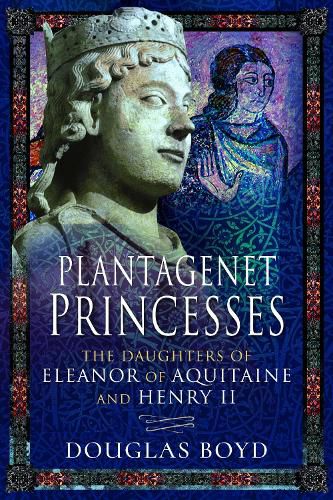Readings Newsletter
Become a Readings Member to make your shopping experience even easier.
Sign in or sign up for free!
You’re not far away from qualifying for FREE standard shipping within Australia
You’ve qualified for FREE standard shipping within Australia
The cart is loading…






The names of few medieval monarchs and their queens are better known than Eleanor of Aquitaine, uniquely queen of France and queen of England, and her second husband Henry II. Although academically labelled ‘medieval’, their era was the violent transition from the Dark Ages, when countries’ borders were defined with fire and sword. Henry grabbed the English throne thanks largely to Eleanor’s dowry because she owned one third of France. Their daughters also lived extraordinary lives. If princes fought for their succession to crowns, the princesses were traded
usually by their mothers
to strangers for political power without the bloodshed. Years before what would today be marriageable age, royal girls were despatched to countries whose speech was unknown to them and there became the property of unknown men; their duty the bearing of sons to continue a dynasty and daughters who would be traded in their turn. Some became literal prisoners of their spouses; others outwitted would-be rapists and the Church to seize the reins of power when their husbands died. Eleanor’s daughters Marie and Alix were abandoned in Paris when she divorced Louis VII of France. By Henry II, she bore Matilda, Alienor and Joanna. Between them, these extraordinary women and their daughters knew the extremes of power and pain. Joanna was imprisoned by William II of Sicily and worse treated by her brutal second husband in Toulouse. If Eleanor was libelled as a whore, Alienor’s descendants include two saints, Louis of France and Fernando of Spain. And then there were the illegitimate daughters, whose lives read like novels… AUTHOR: Douglas Boyd has lived in France for forty years. Author of published works that include fourteen volumes of French and Russian history, he is a former BBC TV producer/director who began collecting first-hand accounts of the French experience of Second World War in 1968 while working on television programmes commemorating the 50th anniversary of the 1918 Armistice. This book is a fruit of that long research. 20 b/w illustrations
$9.00 standard shipping within Australia
FREE standard shipping within Australia for orders over $100.00
Express & International shipping calculated at checkout
The names of few medieval monarchs and their queens are better known than Eleanor of Aquitaine, uniquely queen of France and queen of England, and her second husband Henry II. Although academically labelled ‘medieval’, their era was the violent transition from the Dark Ages, when countries’ borders were defined with fire and sword. Henry grabbed the English throne thanks largely to Eleanor’s dowry because she owned one third of France. Their daughters also lived extraordinary lives. If princes fought for their succession to crowns, the princesses were traded
usually by their mothers
to strangers for political power without the bloodshed. Years before what would today be marriageable age, royal girls were despatched to countries whose speech was unknown to them and there became the property of unknown men; their duty the bearing of sons to continue a dynasty and daughters who would be traded in their turn. Some became literal prisoners of their spouses; others outwitted would-be rapists and the Church to seize the reins of power when their husbands died. Eleanor’s daughters Marie and Alix were abandoned in Paris when she divorced Louis VII of France. By Henry II, she bore Matilda, Alienor and Joanna. Between them, these extraordinary women and their daughters knew the extremes of power and pain. Joanna was imprisoned by William II of Sicily and worse treated by her brutal second husband in Toulouse. If Eleanor was libelled as a whore, Alienor’s descendants include two saints, Louis of France and Fernando of Spain. And then there were the illegitimate daughters, whose lives read like novels… AUTHOR: Douglas Boyd has lived in France for forty years. Author of published works that include fourteen volumes of French and Russian history, he is a former BBC TV producer/director who began collecting first-hand accounts of the French experience of Second World War in 1968 while working on television programmes commemorating the 50th anniversary of the 1918 Armistice. This book is a fruit of that long research. 20 b/w illustrations